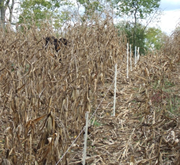Grazing Corn

Many options exist to provide quality grazing during seasons when many common forages have gone dormant. Some non-traditional forages can provide high quality grazing throughout the early fall, late winter, early spring, or hot summer months. Grazing standing corn or corn residue can be a valuable method to extend the grazing season and reduce stored feed needs without the expenses of harvesting and feeding equipment. Corn is mainly produced in Kentucky by livestock producers for grain or silage but this warm-season annual grass can be successfully grazed in summer, fall, or winter.
At heading or tasseling, this high yielding crop is similar in quality and nutritive value to other common forages, but the feed value increases during grain fill while other forages significantly decrease in quality as they mature. Grain is produced at maturity, and dry matter (DM) and total digestible nutrients (TDN) increase while neutral detergent fiber (NDF) and acid detergent fiber (ADF) decrease due to the dilution effect the grain has on the whole plant. Crude protein slightly decreases after plants reach maturity and supplementation is often needed. The majority of the plant provides good quality forage including the leaves, stalks, husks, and ears. If used for late fall and winter grazing, corn plants will lose some leaves and stalks as they begin to break down over winter. This will cause a decrease in digestible nutrients and protein content. Corn still is a good feed for wintering beef cows, stockers, and growing animals due to the high energy content of the grain. Environmental conditions will also affect utilization, feed quality, and rate of quality loss.
Using the best management practices with any forage is important to maximize utilization and reduce waste. Strip grazing will maximize utilization and make the diet more uniform as animals will be forced to graze both high and low quality parts of the plant rather than selectively grazing. This is especially important to aid in the prevention of acidosis or foundering. Trials have shown that it is best to allow enough forage for 2-3 days. The area needed will vary depending on animal size, animal needs, and available forage. Temporary fence is usually run through corn rows by driving down rows with an ATV and running poly wire or poly tape through the field with temporary fence posts. When setting up the fence, it is important to consider the possibility of knocked over stalks falling on the fence. Cattle will graze the corn that is knocked down when setting up the fence so provide enough space between corn and the fence to eliminate cows reaching across pulling corn on the fence or wind blowing corn down on the fence, shorting it out. Many graziers allow livestock access to other stockpiled species, such as tall fescue, while grazing corn to supplement. Access to a grass field is also important as it provides a bedding place.
There are a few precautions to be aware of when grazing corn. First, depending on animal requirements, corn may not supply sufficient protein and it may be necessary to supplement protein. Next, nitrate poisoning may be a possible risk when grazing drought stressed corn. Always test corn when high nitrate levels are suspected. In rare cases, founder has occurred in animals turned onto corn. Gradually transitioning livestock to their new diet, limiting access to encourage uniform grazing, or offering alternative forages can reduce this risk.
Although corn is not a traditional grazing crop, it can provide quality feed in times of the year when other common forages are deficient or dormant. This warm-season grass is actively growing while cool-season grasses have slowed or become dormant during the summer months. Corn can also provide high-quality forage for fall and winter grazing. More information on grazing corn.
Categories:
Fall
Extending the Grazing Season


